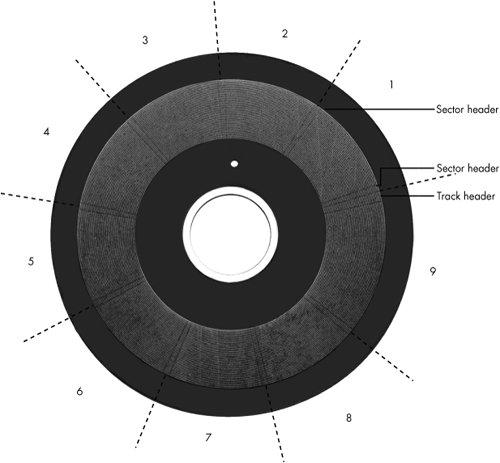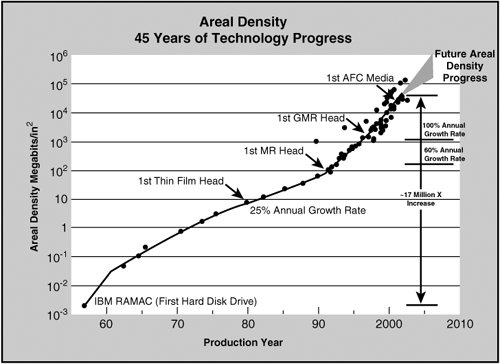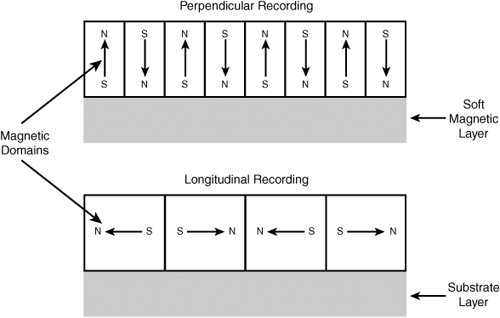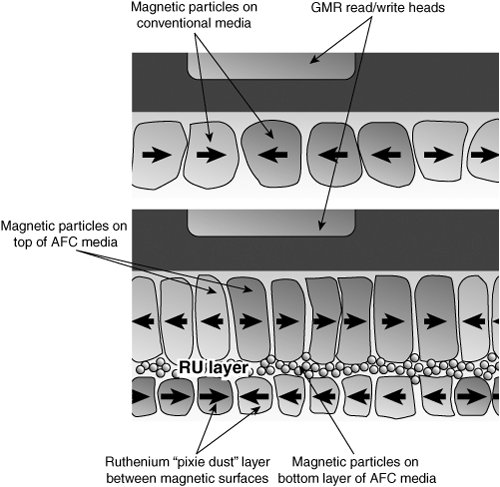Areal Density
| Areal density is often used as a technology growth-rate indicator for the hard disk drive industry. Areal density is defined as the product of the linear bits per inch (BPI), measured along the length of the tracks around the disk, multiplied by the number of tracks per inch (TPI), measured radially on the disk (see Figure 8.11). The results are expressed in units of megabits or gigabits per square inch (Mbit/sq. inch or Gbit/sq. inch) and are used as a measure of efficiency in drive recording technology. Current high-end 3 1/2" drives record at areal densities exceeding 60Gbit/sq. inch (such as the 400GB Hitachi 7K400, which records at 61.7Gbit/sq. inch), whereas 2 1/2" drives such as the 80GB Hitachi 5K80 record at areal densities of 70Gbit/sq. inch or more. Prototype drives with densities of 130Gbit/sq. inch or more now exist, which will enable 3 1/2" drives with capacities of 1 terabyte (TB) or more in the next few years. Figure 8.11. Areal density, combining tracks per inch and bits per inch. Drives record data in tracks, which are circular bands of data on the disk. Each track is divided into sectors. Figure 8.12 shows an actual floppy disk sprayed with magnetic developer (powdered iron) such that an image of the actual tracks and sectors can be clearly seen. The disk shown is a 5 1/4" 360KB floppy, which has 40 tracks per side, with each track divided into 9 sectors. Note that each sector is delineated by gaps in the recording, which precede and postcede the track and sector headers (where ID and address information resides). You can clearly see the triple gap preceding the first sector, which includes the track and sector headers. Then following in a counterclockwise direction, you see each subsequent sector, preceded by gaps delineating the header for that sector. The area between the headers is where the sector data is written. Figure 8.12. 360KB floppy disk media sprayed with magnetic developer (powdered iron) showing the actual track and sector images. Notice that sector 9 is longer than the others; this is to enable rotational speed differences between drives, so that all the data can be written before running into the start of the track. Also notice that a good portion of the disk surface isn't used because it is simply impractical to have the heads travel in and out that far, and the difference in length between the sectors on the inner and outer tracks becomes more of a problem. Areal density has been rising steadily since the first magnetic storage drive (IBM RAMAC) was introduced in 1956, initially at a growth rate of about 25% per year (doubling every four years), and since the early 1990s at a growth rate of about 60% per year (doubling every year and a half). The development and introduction of magneto-resistive heads in 1991, giant magneto-resistive heads in 1997, and AFC pixie dust media in 2001 have propelled the increase in the areal density growth rate. In the 50 years since the RAMAC drive was introduced, the areal density of magnetic storage has increased more than 17 million fold. At the current growth rate, within the next three years or so, drive manufacturers will achieve areal densities of approximately 250Gbit/sq. inch, which was previously considered beyond the point at which the superparamagnetic effect takes place. This is an effect in which the magnetic domains become so small that they are intrinsically unstable at room temperature. Techniques such as extremely high coercivity media and perpendicular recording are being employed to enable magnetic storage densities of 500Gbit/sq. inch to possibly 1000Gbit/sq. inch or more, but beyond that, scientists and engineers might have to look toward other technologies. One such technology being considered for the future is holographic storage, in which a laser writes data three-dimensionally in a crystal plate or cube. Figure 8.13 shows how areal density has increased from when magnetic storage was first developed (1956 RAMAC) through the present time. Figure 8.13. Evolution of areal density in magnetic disk storage. To increase areal density while maintaining the same external drive form factors, drive manufacturers have developed media and head technologies to support these higher areal densities, such as ceramic/glass platters, GMR heads, pseudo-contact recording, and PRML electronics, as discussed earlier in this chapter. The primary challenge in achieving higher densities is manufacturing drive heads and disks to operate at closer tolerances. Improvements in tolerances and the use of more platters in a given form factor continue to fuel improvements in drive capacity, but drive makers continue to seek even greater capacity increases, both by improving current technologies and by developing new ones. To fit more data on a platter of a given size, the tracks must be placed more closely together and the heads must be capable of achieving greater precision in their placements over the tracks. This also means that as hard disk capacities increase, heads must float ever closer to the disk surface during operation. The gap between the head and disk is as close as 10 nanometers (0.01 microns) in some drives, which is approximately the thickness of a cell membrane. By comparison, a human hair is typically 80 microns in diameter, which is 8,000 times thicker than the gap between the head and disk in some drives. The prospect of actual contact or near contact recording is being considered for future drives to further increase density. Increasing Areal Density with Pixie DustIn 1990, IBM scientists discovered that a thin layer of the element ruthenium was the most effective nonmagnetic element that could be used for spacers in devices such as GMR heads. However, more than a decade passed before the first commercially available application of this principle was used to increase disk drive storage densities by improving the storage density of the drives' platters. In May 2001, IBM began to produce drives using "pixie dust" technology in its Travelstar 2 1/2" hard drive series for notebook computers. In November 2001, Deskstar GXP drives using the same technology were introduced, and these drives had capacities of 80GB and 120GB. These drives achieved data densities exceeding 25Gb per square inch through the use of a thin (three-atom-thick) layer of ruthenium used to separate two magnetic surfaces on each side of the drive's platters. Traditional drives use platters with a single magnetic surface per side. Media using the ruthenium coating, commonly referred to as pixie dust, is technically known as antiferromagnetically coupled (AFC) media. IBM continues to use AFC media in its latest drives for notebook, desktop, and server computers and has licensed AFC media to other drive and media vendors. AFC media was developed because achieving greater and greater densities of magnetic storage requires individual magnetic areas on the media to become smaller and smaller. However, when magnetic areas become too small, a problem called the superparamagnetic effect (which causes magnetic areas to lose their magnetism over time) can occur. When a thin layer of ruthenium is placed between two magnetic layers, the layers are forced to orient themselves magnetically in opposite directions to each other. Although the three-layer structure is physically thicker than a conventional magnetic surface, the opposing magnetic orientations make the layers appear to be thinner than a conventional surface. As a result, disk drive read/write heads can record smaller, high-density signals, increasing the storage capacity of a given platter size without the risk of the signal degrading. Figure 8.14 compares a normal single-layer disk platter to a disk platter using pixie dust AFC media technology. Figure 8.14. Conventional media uses a single magnetic surface, whereas AFC media uses two magnetic surfaces separated by a thin layer of ruthenium, a process IBM refers to as pixie dust. Just as GMR heads use two layers separated by a thin conductive layer to increase data storage density, AFC media uses a similar principle. In essence, AFC media represents an extension of GMR principles from the read/write heads to the media's data recording surfaces. Over time, AFC media more than quadrupled the storage capacity of magnetic media, enabling drives to reach capacities of 100Gb per square inch or more. Perpendicular Magnetic RecordingVirtually all hard drives and other types of magnetic media record data using longitudinal recording, which stores magnetic bits horizontally across the surface of the media. However, perpendicular recording, which aligns magnetic signals vertically on the media surface, has the potential to achieve higher data densities because vertically oriented magnetic bits use less space than longitudinally stored bits (see Figure 8.15). Currently, all the major drive vendors are working with perpendicular recording as a way to achieve signal density surpassing that achievable even with AFC pixie dust media. Figure 8.15. Perpendicular versus longitudinal recording. Conventional magnetic recording places magnetic domains longitudinally, meaning the domains lie end to end on the disk. This not only limits the density of the domains, but also helps to enable the superparamagnetic effect, in which domains placed too closely together begin to interact, causing their polarities to change and essentially making them unstable. Long ago it was realized that, if one could place the domains perpendicular to the media (also called a vertical recording), you could increase the density as well as increase the resistance of the domains to the superparamagnetic effect. Although the concept was easy to understand, actually implementing it has been difficult. Unlike GMR heads and AFC mediaboth of which can be added relatively easily to existing drive technologiesperpendicular recording requires entirely new read/write head designs. Figure 8.15 shows the difference between perpendicular and longitudinal recording. You can get at least twice the number of magnetic domains in the same space with perpendicular recording. Using perpendicular recording, the heads are designed to write deep into the media, using a thicker soft magnetic underlayer as a return path for the magnetic field. This enables the domains to be vertically aligned, and therefore placed much more closely together without unwanted interaction problems. Perpendicular recording was first demonstrated in the late nineteenth century by Danish scientist Valdemar Poulsen, who was also the first person to demonstrate that sound could be recorded magnetically. There weren't many advances in perpendicular recording until 1976 when Dr. Shun-ichi Iwasaki (president of the Tohoku Institute of Technology in Japan) verified the distinct density advantages in perpendicular recording. Then in 1978, Dr. T. Fujiwara began an intensive research and development program at the Toshiba Corporation that eventually resulted in the perfection of floppy disk media optimized for perpendicular recording and the first commercially available magnetic storage devices using the technique. The first use of perpendicular recording in PCs was with the 3 1/2", 2.88MB ED (extra-high density) floppy format developed by Toshiba and officially announced in 1987, with the ED drives and disks finally reaching production in 1989. IBM officially adopted these drives in its PS/2 systems in 1991, and a number of manufacturers began making them for IBM and other PC manufacturers, including Toshiba, Mitsubishi, Sony, and Panasonic. Because a 2.88MB ED drive can fully read and write 1.44MB HD disks, because BIOS manufacturers fully integrated 2.88MB floppy support in the BIOS, and because DOS 5.0 and later included support for the 2.88MB format, the change to 2.88MB was an easy one. Unfortunately, due to high media costs and a relatively low increase in data capacity at a time when floppy disks were being replaced by writable CDs, these drives never caught on. Despite the 2.88MB ED floppy's failure in the marketplace, Toshiba and other companies continued developing perpendicular magnetic recording for other media, especially hard disk drives. In April 2002, Read-Rite Corporation, a major maker of read/write heads, reached areal densities of 130Gb/sq. inch in a prototype drive using media provided by Maxtor subsidiary MMC Technology. In November 2002, Seagate Technology announced it had achieved areal densities of more than 100Gb/sq. inch in a prototype drive using this technology as well. According to two independent studies published in 2000, perpendicular recording was projected to enable densities of 500Gb[nd]1000Gb (1 terabit) per square inch in the future. Perpendicular recording finally became commercially available in hard disk drives on August 16, 2005, when Toshiba's Storage Device Division announced shipment of the world's first hard disk using PMR. These were 1.8" drives used primarily in portable consumer electronics devicesmost notably the Apple iPod media players, but also found in some of the smallest laptop PCs, such as the Toshiba Libretto series. The first 1.8" drives using PMR are the 40GB and 80GB models, which store 40GB on a single platter and are available in single-platter 40GB and dual-platter 80GB versions. These drives feature the highest areal density of any drives currently on the market at 133Gb/sq. inch (206Mb/sq. mm.). Although not normally used in PCs, these drives can be found in some of the extremely small and lightweight laptop systems such as the Toshiba Libretto. Seagate introduced the first 2.5" PMR-based hard disk with the Momentus 5400.3 160, a 160GB 2.5" drive designed primarily for laptops. Although Seagate announced the drive in June 2005, it wasn't actually available for purchase until the first quarter of 2006. Seagate also demonstrated recording an areal density of 245Gb/sq. inch with a data rate of 480Mbps using PMR and has indicated it will be able to achieve 500Gb/sq. inch in the future, which will increase the capacity of drives five times compared to those using conventional longitudinal recording. At an areal density of 500Gb/sq. inch, a 3.5" drive could store 2TB, a 2.5" drive in a laptop could hold 500GB, and a 1" Microdrive could store as much as 50GB of data. Other manufacturers are also developing PMR drives. In April 2005, Hitachi demonstrated a perpendicular recording data density of 230Gb/sq. inch, which it indicated could result in a 20Gb Microdrive being released in 2007. Note that Microdrives are used in portable media players such as the Apple iPod Mini, Creative Muvo, and Zen Micro. In the future, it is expected that most if not all of the hard drive manufacturers will introduce PMR-based drives to continue the trend of incredible capacity growth in magnetic storage. |
EAN: 2147483647
Pages: 283
- ERP System Acquisition: A Process Model and Results From an Austrian Survey
- The Second Wave ERP Market: An Australian Viewpoint
- Context Management of ERP Processes in Virtual Communities
- Distributed Data Warehouse for Geo-spatial Services
- Healthcare Information: From Administrative to Practice Databases
